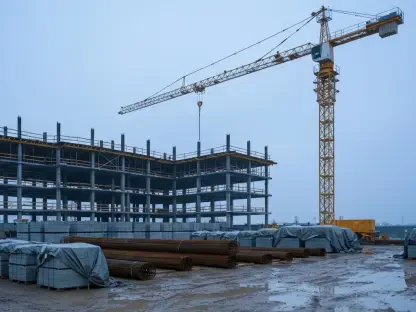Artificial Intelligence (AI) is making waves across numerous industries, transforming traditional processes and boosting efficiency. However, one sector where AI’s integration remains surprisingly stagnant is construction. Despite its staggering $13 trillion valuation, the construction industry’s productivity has scarcely grown, revealing a pressing need for transformation. AI offers a promising path to modernize capital program management, addressing many of the critical challenges faced in this sector. From untapped data potential and siloed systems to fragmented processes and technological hesitancy, AI shines a light on the path forward for the construction industry. By seeing AI as a strategic partner, the construction sector can not only lift itself out of productivity stagnation but also set new benchmarks for efficiency and innovation.
Understanding Current Challenges in Capital Program Management
The construction industry’s capital program management faces significant hurdles that hinder progress and efficiency, ranging from untapped data potential to reactive management approaches. One notable issue is the staggering 96% of construction data that remains unused. This data could offer valuable insights if effectively leveraged, yet it lies dormant within the existing frameworks. Adding to this is the prevalence of siloed systems within construction firms, where disconnected systems foster communication gaps and result in delays and poor decision-making.
The fragmentation between different processes further augments inefficiencies, slowing overall progress. Another critical challenge is the sector’s technological hesitancy. The construction industry has been traditionally slow in adopting new technologies, which has stagnated productivity growth. This slow adoption rate significantly contrasts with other sectors that have rapidly progressed thanks to technological advancements. The combination of these factors forms a complex web of inefficiencies that modern solutions, especially AI, are uniquely positioned to untangle and optimize.
Economic Implications of Inefficiencies
These inefficiencies do not simply delay project timelines; they also lead to significant economic consequences. The notorious California High-Speed Rail project serves as a prime example, with initial costs ballooning from an estimated $33 billion to a staggering $128 billion. Such cost overruns are not just minor inconveniences but substantial economic burdens that strain budgets and delay project completion. Moreover, exacerbating these financial challenges is the issue of workforce shortages. It’s reported that 91% of U.S. construction firms struggle with a lack of skilled labor, which adds additional risks to projects and complicates infrastructure development further.
The economic implications extend beyond increased expenses and delayed timelines; they impact the overall viability of critical infrastructure projects. As projects run over budget and fall behind schedule, the broader economic impact can be severe, affecting everything from job creation to regional economic growth. Given these significant challenges, the construction industry desperately needs a paradigm shift in how capital program management is approached, with AI being a game-changer on this front.
AI’s Potential to Transform Planning
Significant funding allocations for transforming infrastructure such as roads, airports, and cities underscore the need for smart planning. However, it is through AI that capital planning can become a truly data-driven decision-making process. AI algorithms can analyze factors such as strategic alignment and funding availability to simulate high-risk areas and recommend mitigation strategies. This aids in prioritizing projects based on their strategic significance and anticipated outcomes, thereby ensuring that resources are allocated efficiently for maximum impact.
Additionally, AI offers robust scenario planning capabilities. With what-if analyses, stakeholders can evaluate variables like price changes, enabling them to make informed decisions about resource allocation. This proactive approach allows for better responses to uncertainties, reducing risks and ensuring project continuity under fluctuating conditions. Through AI-driven simulation and forecasting, capital planning evolves from a reactive to a proactive practice, empowering teams to set more accurate plans and budgets.
Enhancing Community Engagement
Engaging with the community is not only a crucial but also a legally mandated activity for many government agencies, yet traditional methods of engagement often fall short of their goals. Fortunately, AI can dramatically enhance feedback collection and sentiment analysis. By analyzing multiple input channels such as surveys and social media, AI provides a more inclusive understanding of community needs, ensuring diverse voices are heard and considered in the planning and execution phases.
With AI-driven sentiment analysis, understanding the tone and context of feedback is more precise, aiding in accurate representation of public priorities. This ensures that project decisions are well-aligned with community expectations. Moreover, AI accelerates feedback collection and analysis, reducing costs and enabling quicker, more informed decision-making. By leveraging AI, agencies can transform community engagement from a checkbox exercise into a dynamic, responsive dialogue that brings tangible benefits to projects and the communities they serve.
Transforming the Design Phase with AI
The design phase is pivotal for the success of any construction project, and AI-driven tools can significantly transform this crucial stage, balancing constraints and fostering innovation. Generative AI, for instance, enables teams to explore countless design iterations to meet specific project constraints. This iterative refinement ensures the selection of optimal design solutions that are not only innovative but also practical and feasible.
In addition to iterative design, AI aids in early clash detection, preventing potential conflicts before they evolve into costly issues. AI models can validate designs against functional and environmental requirements, reducing the likelihood of rework and associated costs. Furthermore, AI-powered recommender systems analyze historical data and project-specific constraints to suggest tailored solutions, such as cost-effective structural connections and material options.
The integration of AI in the design phase simplifies complex processes, minimizes errors, and promotes innovation, ensuring that projects get off to the right start and maintain a clear path to success.
Enhancing Construction Management
The complexities of construction management can be daunting, but AI offers powerful solutions that empower management teams to deliver seamless project execution. One key area where AI makes a significant impact is occupational safety. Given the hazardous nature of construction, AI systems can identify high-risk activities and ensure compliance with safety norms, thereby reducing accidents. Computer vision models, for example, can monitor whether workers are wearing proper personal protective equipment (PPE) and help avoid costly penalties from agencies like OSHA.
Labor optimization is another area where AI shines. By analyzing data to predict labor needs, AI ensures effective resource allocation, addressing labor challenges proactively. This hybrid approach helps in precise labor planning and adjusts dynamically to changing conditions like weather disruptions, ensuring that human resources are efficiently distributed in real-time to align with project timelines.
Revolutionizing Document and Equipment Management
Effective document and equipment management are critical to the smooth operation of any construction project. AI-powered optical character recognition (OCR) transforms physical documents into searchable digital formats, streamlining information retrieval and ensuring data security. Digital documents are securely stored, enhancing resilience during emergencies and facilitating easy and reliable access when needed. This digitization not only increases efficiency but also reduces administrative costs significantly.
For equipment management, AI offers tools for real-time tracking and monitoring. Object detection models enable accurate tracking of equipment, while drones equipped with AI provide high-resolution imagery for effective site monitoring. These technologies reduce coordination delays by offering precise location data, thus optimizing resource allocation. By incorporating AI into these facets of construction management, projects run more smoothly, and resource utilization becomes more effective.
Advanced Risk Management
Risk management is a critical aspect of construction, and here too, AI proves invaluable by shifting the focus from reactive to proactive methodologies. Machine learning models predict potential risks before they manifest, allowing for early mitigation. For instance, AI-powered alerts can proactively trigger mitigation strategies well in advance of an issue becoming a significant problem. By doing this, risks are managed more efficiently, reducing the likelihood of costly delays or accidents down the line.
Moreover, AI facilitates a more thorough analysis of potential risks, providing a comprehensive understanding that aids in developing effective strategies. This intelligent risk identification and management improve overall project safety and financial performance, ensuring projects stay on track and within budget. Consequently, AI not only enhances the predictive capabilities of risk management but also fortifies the entire construction process against unforeseen disruptions.
AI-Driven Communication and Collaboration
Effective communication and collaboration are fundamental to the success of construction projects, and AI-driven solutions significantly enhance these areas. Conversational AI tools, such as voice-activated assistants, streamline tasks by allowing team members to update schedules, report issues, and retrieve information quickly and easily. These tools minimize delays and ensure that all team members have access to up-to-date information at all times.
Furthermore, natural language processing (NLP) technology enables generative AI systems to answer questions and analyze data efficiently. This reduces wait times for critical information, enhancing overall productivity and helping keep projects on schedule. By improving the speed and quality of communication and collaboration, AI ensures that all stakeholders are aligned, informed, and able to make well-informed decisions promptly.
Enhancing Maintenance and Operations
Post-construction, the maintenance and operation phase is crucial for the long-term success of infrastructure. AI offers automated, data-driven solutions that enhance infrastructure maintenance, resulting in significant cost savings and improved efficiency. Advanced computer vision models can detect infrastructure damage in real-time, eliminating the need for manual inspection and reducing associated costs. This proactive approach ensures that issues are identified and addressed before they escalate.
Internet of Things (IoT) devices provide real-time data that AI uses for precise maintenance planning. These intelligent systems prioritize repairs based on urgency, shifting the focus from reactive fixes to proactive strategies. Additionally, AI automates survey and inspection processes, improving the efficiency and accuracy of data collection. By leveraging advanced technologies for detailed mapping and inspection, AI ensures comprehensive maintenance planning, extending the lifespan of infrastructure and enhancing overall performance.
Charting the Path Forward in Construction
AI presents a remarkable opportunity to reframe and revolutionize capital program management in the construction sector. By addressing key challenges such as cost overruns, project delays, and safety risks through AI-fueled insights and predictive analytics, agencies can make more informed decisions and optimize workflows. This integration promises enhanced outcomes for communities and stakeholders alike. The strategic adoption of AI, however, transcends mere technology deployment; it necessitates a transformation in organizational culture, process redesign, and team skillsets.
Embracing AI in construction management can truly redefine traditional processes. It streamlines operations, optimizes resource allocation, and enhances decision-making, setting a new standard for efficiency and innovation in the sector. While the journey requires a holistic approach, the rewards in productivity, safety, and project delivery are well worth the endeavor.
The benefits of AI are not purely theoretical; they are being realized in projects worldwide. By integrating AI across planning, design, construction management, and maintenance phases, the construction industry can position itself at the forefront of technological advancement. This integration not only resolves current inefficiencies but also sets the stage for a future where excellence, sustainability, and productivity are the norms. By leveraging AI’s full potential, the construction sector can indeed usher in a new era of innovation and efficiency.









